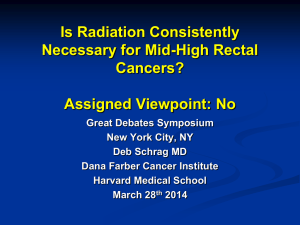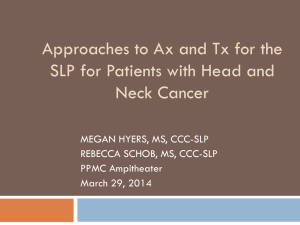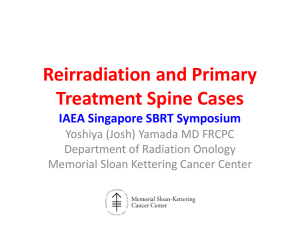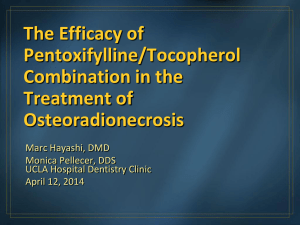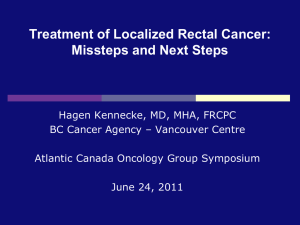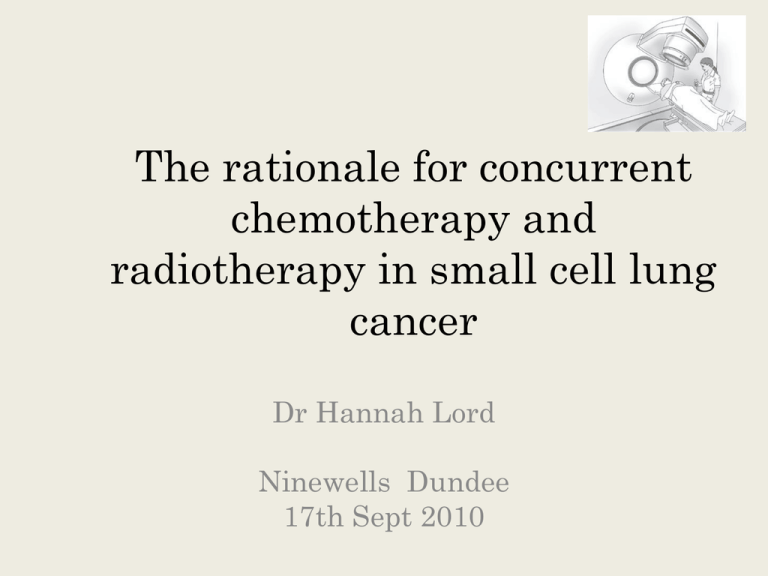
The rationale for concurrent
chemotherapy and
radiotherapy in small cell lung
cancer
Dr Hannah Lord
Ninewells Dundee
17th Sept 2010
Small Cell
20% of all lung cancer
Associated with smoking
Rapid doubling time
Falling incidence in many parts of UK,
not in Scotland
• A systemic disease, even when staged as
“localised.” As such, systemic treatment
is vital.
•
•
•
•
The History
• In 1969, 5 year survival:
1% with surgery
4% with radiotherapy
• In 1970s, advent of platinum based
chemotherapy.
• Led to 4-5 fold improvement in response
rates
Small Cell
• With chemo, excellent responses, but
early and frequent relapse.
• Need to build on the improvement.
XRT
• XRT already well known as effective.
• XRT potentiates the effect of
chemotherapy
• XRT has non over-lapping toxicities with
chemotherapy
• XRT has different mode of action and
may deal with potentially
chemoresistant disease
Evidence For XRT
• 13 randomised controlled trials have investigated
the role of XRT
• Pignon(1) 1992 meta-analysis (and Warde(2) 1993)
• 2103 patients with LD
• 433 had ED
1.
2.
Pignon JP et al, N Engl J Med 1992; 327:1618-1624 December 3, 1992
Warde P et al “Does thoracic irradiation improve survival and local control in limited stage small cell
carcinoma of the lung?” JCO 1992;10:890-895
• 3 year survival improved
from 8.9% to 14.3%
(5% improvement)
• HR = 0.86 = 14% reduced
risk of death
• No difference if LD / ED or
timing of XRT
Role of XRT
• Value of XRT proven.
• Principles of radiotherapy are to give the
treatment in as short a time as possible
for maximum effectiveness
• Minimise re-growth of tumour, which is
known to have a rapid doubling time
XRT
• Concurrent treatment:
i) To reduce overall treatment time
(repopulation of tumour)
ii) To allow 2 modalities to potentiate
one another
ii) ? to improve outcomes
How to determine timing of XRT?
•
•
•
•
Randomised controlled trials
8 looking at timing of XRT
3 positive
5 negative
Trial 1: NCIC study (3) 1993
• Randomised controlled trial in Canada
• 308 pts
• XRT commencing at cycle 2 (week 3) vs. cycle 6 (week
15)
• 40Gy in 15 fractions given
3. N Murray et al Importance of timing for thoracic irradiation in the combined
modality treatment of limited-stage small-cell lung cancer. JCO Vol 11 336-344, 1993
The National Cancer Institute of Canada Clinical Trials Group
NCIC Results
Early XRT
Late XRT
p Value
PFS
15.4
11.8
0.36
OS (
median)
21.2
16.0
0.008
3 year
survival
30%
22%
0.008
5 year
survival
26%
11%
0.008
Trial 2: Jeremic (4)
•
•
•
•
•
Yugoslavian study 1997
107 patients
4 x Carbo Etop and 4 x Cis Etop (carbo with XRT)
54Gy in 1.5Gy / fraction given bd
XRT weeks 1-4 (early)
or
weeks 6-9 (late)
Early
Late
P value
Median
survival
(months)
34
26
0.027
5 year survival
(%)
30
15
0.027
4. Jeremic et al “Initial versus delayed accelerated hyperfractionated radiation therapy
and concurrent chemotherapy in limited small-cell lung cancer: a randomized study”
JCO Vol 15, 893-900, 1997
Trials 3: Takada (5)
• Japanese study 2006
• 231 patients
• 4 x EP with 45Gy in 1.5Gy fractions given bd
• XRT started d2 cycle 1
vs.
sequential rather than late)
after cycle 4 (
5. Takada M, Fukuoka M, Kawahara M, et al: Phase III study of concurrent versus sequential
thoracic radiotherapy in combination with cisplatin and etoposide for limited-stage small-cell lung
cancer: Results of the Japan Clinical Oncology Group Study 9104. J Clin Oncol 20: 3054-3060,
2002
Results
Concurrent
Sequential
Median survival
(months)
27.2
19.7
2 year survival (%)
54.4
35.1
3 year survival (%)
29.8
20.2
5 year survival (%)
23.7
18.3
P= 0.097
not significant due to small sample size
Costs of XRT
• Increased haematolgical toxicity
• Similar oesophagitis ( 9% vs 4%)
• 1% incraese in treatment related deaths
• Well tolerated overall
Negative trials 1: Perry (6)
• US Study 1987
• 399 patients: chemo, vs. chemo + early XRT, vs.
chemo + late XRT
• Results:
• XRT group as a whole did better that chemo
alone group
• But no benefit from early vs delayed XRT
6. Perry MC et al Chemotherapy with or without radiation therapy in limited small cell lung carcinoma of the
lung NEJM 1987;316:912-918
Negative trials 2: Spiro
• A London based trial (7) published 2005, replicated
the NCIC study.
• 3 cycles of CAV followed by 3 cycles of EP
• XRT with first course of EP (4th cycle of chemo) vs.
XRT with last course (6th) of chemo
• Failed to demonstrate a survival advantage from
early XRT with chemo.
7. Spiro SG et al JCO Vol 24 No 24 2006: pp. 3823-3830 2006 Early Compared With Late Radiotherapy in
Combined Modality Treatment for Limited Disease Small-Cell Lung Cancer: A London Lung Cancer Group
Multicenter Randomized Clinical Trial and Meta-Analysis
Negative trials 3-5
• Work et al, James et al, Gregor et al, all
negative.
• No advantage shown to early XRT
What do we do?
A meta-analysis!
Meta-analysis 2004 (6)
• Looked at 7 studies (Spiro not published at
that time - 2006)
• 1524 patients
Outcome
In favour of
early XRT
2 year survival
1.17 (CI = 1.02-1.35)
Relative risk
3 year survival
1.13 (CI = 1.13-0.92)
Relative risk
(not significant)
6. B. Fried et al Systematic Review Evaluating the Timing of Thoracic Radiation Therapy in Combined Modality
Therapy for Limited-Stage Small-Cell Lung Cancer JCO Vol 22, No 23 , 2004: pp. 4837-4845 2004 American Society of
Clinical Oncology.DOI: 10.1200/JCO.2004.01.178
Meta-analysis Summary
• A small but significant improvement in
2-year OS for ERT versus LRT
• Similar to the benefit of adding RT to
chemotherapy, or to addition or
prophylactic cranial irradiation.
Cautions:
• Studies using platinum-based chemotherapy had
2 year OS RRs of 1.30 (95% CI, 1.10 to 1.53; P 0.002)
favouring early XRT.
3 year OS RRs of 1.35 (95% CI, 1.07 to 1.70; P 0.01)
BUT:
• Studies using once-daily fractionation showed no difference in 2and 3-year OS for early vs. late XRT.
• Studies using non-platinum-based chemotherapy regimens had
non-significant differences in OS.
• Next Step?
Cochrane Review
• OS at 2 and 5 years:
not significantly different for early vs late XRT.
• However, if removed 1 trail, which did not use platinum,
survival advantage at 5 years for early vs. late OR = 0.64
p=0.02
• If XRT was given within < 30 days:
5 year survival was even better OR=0.56 p = 0.02
So……
• Radiotherapy adds to chemotherapy
without doubt
• Early appears to be superior to late, but
this is more evident when given with
platinum based chemo, and if given in
hyperfractionated manner (i.e. bd)
• Short overall treatment time is best
Future
• Are you convinced? Or confused?
• bd fractionation ? Do we move to this?
CONVERT study ongoing to clarify this
question in UK and Europe
• Dose escalation – no proof that higher
doses lead to better outcomes ( although
common in N America - get paid / fraction)
Thank you and any
Questions

